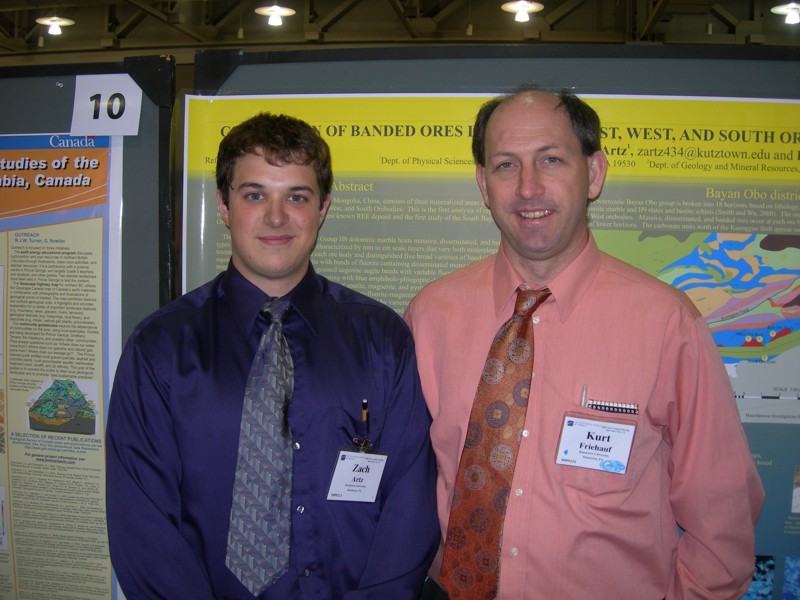
 Comparison
of Banded Ores in the Main/East, West, and South Orebodies of
the Giant Bayan Obo REE District, Inner Mongolia, China
Comparison
of Banded Ores in the Main/East, West, and South Orebodies of
the Giant Bayan Obo REE District, Inner Mongolia, China
Artz,
Zachary J., Friehauf,
Kurt C., and Xiao, Rongge, 2005, Comparison
of
Banded
Ores in the Main/East, West, and South Orebodies of the Giant
Bayan Obo REE District, Inner Mongolia, China [abs.]:
Geological Society of America Annual Meeting (October 16-19, 2005)
Salt Lake City, UT, Program with Abstracts, vol. 37, no. 7, p. 500.
 The Bayan Obo REE District in Inner Mongolia,
China, consists of three mineralized areas distributed over a 13 x
1.5 km region: the Main/East, West, and South Orebodies. This is the
first analysis of regional spatial trends in mineralization in the
world's largest known REE deposit and the first study of the South
Bayan Obo Orebodies.
The Bayan Obo REE District in Inner Mongolia,
China, consists of three mineralized areas distributed over a 13 x
1.5 km region: the Main/East, West, and South Orebodies. This is the
first analysis of regional spatial trends in mineralization in the
world's largest known REE deposit and the first study of the South
Bayan Obo Orebodies.
The Middle Protereozoic Bayan Obo Group H8 dolomitic marble hosts
massive, disseminated, and banded ore types in all three areas.
Banded ore is characterized by mm to cm scale layers that vary both
mineralogically and texturally. We surveyed and sampled each ore
body and distinguished five broad varieties of banded ore: 1)
equant, medium-grained quartz-fluorite with bands of fluorite
containing disseminated monazite, highly variable magnetite, and
trace pyroxene; 2) fine-grained aegerine augite bands with variable
fluorite, magnetite, and trace apatite; 3) weakly banded magnetite
alternating with blue amphibole-phlogopite-dolomite bands; 4)
fine-grained carbonate-fluorite-limonite with trace amounts of
apatite, magnetite, and pyrite; 5) evenly disseminated magnetite in
weakly to moderately banded coarse-grained
dolomite-fluorite-magnetite with fine-grained phlogopite and
diopside. Samples from the Main/East Orebodies are typified by
varieties 1, 2, and 3, with much variation in the content of REE
minerals, whereas varieties 4 and 5 typify the West and South
Orebodies, respectively.
Limonite is much more common in the distant West Orebodies and
sulfides are sparse in the Main/East and South Orebodies, suggesting
the West Orebodies were initially richer in pyrite. If the South
Orebodies are continuous with the Main/East Orebodies beneath the H9
syncline, the dominantly disseminated nature of the South Orebodies,
the paucity of fluorite and aegerine-augite, the lower REE grades,
and greater calcite content may indicate a more distal position of
the South Orebodies within the ore-forming system.
The presence of rhythmic pyroxene/fluorite-carbonate bands that wrap
around breccia fragments indicates some banding formed due to
metasomatic replacement. Boudinage in some banded ores and
granoblastic textures indicate post-banding deformation and a
possible metamorphic origin or modification for some banding.

 Comparison
of Banded Ores in the Main/East, West, and South Orebodies of
the Giant Bayan Obo REE District, Inner Mongolia, China
Comparison
of Banded Ores in the Main/East, West, and South Orebodies of
the Giant Bayan Obo REE District, Inner Mongolia, China

 Comparison
of Banded Ores in the Main/East, West, and South Orebodies of
the Giant Bayan Obo REE District, Inner Mongolia, China
Comparison
of Banded Ores in the Main/East, West, and South Orebodies of
the Giant Bayan Obo REE District, Inner Mongolia, China
 The Bayan Obo REE District in Inner Mongolia,
China, consists of three mineralized areas distributed over a 13 x
1.5 km region: the Main/East, West, and South Orebodies. This is the
first analysis of regional spatial trends in mineralization in the
world's largest known REE deposit and the first study of the South
Bayan Obo Orebodies.
The Bayan Obo REE District in Inner Mongolia,
China, consists of three mineralized areas distributed over a 13 x
1.5 km region: the Main/East, West, and South Orebodies. This is the
first analysis of regional spatial trends in mineralization in the
world's largest known REE deposit and the first study of the South
Bayan Obo Orebodies.